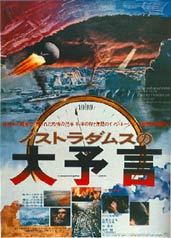Prophecies of Nostradamus
| Prophecies of Nostradamus | |
|---|---|
 Theatrical release poster | |
| Directed by | Toshio Masuda |
| Screenplay by | Toshio Yasumi |
| Based on | Prophecies of Nostradamus: The Approaching Month of July 1999 and the Day of Humanity's Collapse[1] by Ben Goto |
| Produced by | |
| Starring | Tetsuro Tamba |
| Cinematography | Rokuro Nishigaki[3] |
| Edited by | Nobuo Ogawa |
| Music by | Isao Tomita[3] |
Production companies | |
| Distributed by | Toho |
Release date |
|
Running time | 112 minutes[3] |
| Country | Japan |
| Budget | ¥650 million |
| Box office | ¥883 million |
Prophecies of Nostradamus (ノストラダムスの大予言, Nosutoradamusu no daiyogen) is a 1974 disaster film by Toshio Masuda, based on a 1973 novel by Ben Goto, itself inspired by the prophecies of Nostradamus.
Plot
In 1853, Genta Nishiyama begins preaching the prophecies of
In the present day of 1999, biologist Dr. Ryogen Nishiyama is called in to analyze recent scientific phenomena, such as the appearance of large mutant slugs, children wielding advanced abilities after drinking water near a zinc mine, and large ice packs just north of Hawaii. He is also a leading figure in the fight against environmental pollution, natural disasters, and the global arms race. The U.N. sends a research expedition to New Guinea to investigate a radioactive dust cloud that appeared over the island, but the team suddenly goes out of all contact. Nishiyama joins a second team to find them and discover that the area around the team's last known position is now infested by large mutant bats and leeches; one leech renders a team member unconscious and he later turns violently insane after the team sets up camp. He is sedated, but is later feasted on by cannibals. The team fight off the cannibals and chase them into a cave, where they find the remains of the original group, but are disheartened that some of them are barely alive; they are forced to kill and bury the survivors.
A SST jet explodes in the atmosphere over Japan, with the explosion puncturing the ozone layer and unleashing ultraviolet radiation below. The polar icecaps melt, triggering massive floods in Japan. After more natural disasters hit the country, the civilian populace turns to looting as rationing takes effect. Society breaks down further, with several people committing suicide. The panic escalates until nuclear war breaks out, devastating humanity. Most of the survivors are left mutated, and fight each other for food among the ruins of civilization.
It is revealed that the nuclear war is one of many nightmare scenarios Nishiyama is explaining before the Japanese Cabinet. As the prime minister explains a resolve to find a solution, Nishiyama, his daughter Mariko, and her boyfriend Akira (a globetrotting photographer) leave the
Cast
- Tetsurō Tamba as Dr. Nishiyama
- Toshio Kurosawa as Akira Nakagawa
- Kaoru Yumi as Mariko Nishiyama
- Yoko Tsukasa as Nobuo Nishiyama
- Tappie Shimokawa
- So Yamamura as Prime Minister
- Katsu Ryuzaki as Daikon
- Kyōko Kishida as the narrator[3]
Production
This was Toho's second disaster movie following the previous year's
A proposed sequel was to be called Prophecies of Nostradamus 2: Lord of Terror. The premise was for the audience of a Ben Goto lecture slipping through time to July 1999, witnessing the apocalyptic events of Nostradamus’ quatrains.[7]
In May 1974, while shooting a forest fire effects scene, the miniatures ignited and burned out of control. Toho's Studio 7 in Kinuta, Setagaya-Ku was a total loss, though there were no injuries.[7]
Release
Prophecies of Nostradamus was released theatrically in Japan on 3 August 1974 where it was distributed by Toho.[3] Toho released their 90-minute international version in the United States on 13 July 1979.[3] It was later released to television by United Productions of America as The Last Days of Planet Earth with English dubbing.[3] The television print runs 88 minutes in length.[3] It was released on EP VHS in the 1990s by Paramount Home Video.
Prophecies of Nostradamus is infamous for its depiction of mutated human beings. After the film was released, a protest group lodged a complaint with the
References
Footnotes
- ^ ノストラダムスの大予言 迫りくる1999年7の月、人類滅亡の日, Nosutoradamusu no Daiyogen: Semari-kuru 1999-nen Nana no Tsuki, Jinrui Metsubō no Hi
- ^ Galbraith IV 2008, p. 297.
- ^ a b c d e f g h i Galbraith IV 2008, p. 298.
- )
- )
- )
- ^ )
- ^ Patrick Macias. TokyoScope - The Japanese Cult Film Companion. Cadence Books, 2001. Pg. 167
Sources
- Galbraith IV, Stuart (2008). The Toho Studios Story: A History and Complete Filmography. ISBN 978-1461673743.
External links
- Prophecies of Nostradamus at IMDb
- Prophecies of Nostradamus at AllMovie
- The Last Days of Planet Earth at AllMovie
- Last Days Of Planet Earth at Manor on Movies
- Article and promotional poster for the proposed sequel (Japanese language)
- Prophecies of Nostradamus (1974), Japanese edit/Japanese language with English subtitles
- The Last Days of Planet Earth (1979), US edit/English language
